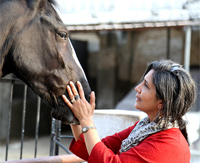Journalist-PR pro ties on brink of complete change in 2017
PR Insight
Paarul Chand
There was a time, less than five years ago, when a PR pitch via an informal messaging platform would have been cause to ignore the PR request. Now, without wincing, I receive entire story pitches on WhatsApp and interviews too! The relationship, between a PR pro and a journo, thanks to social media has changed completely in many fundamental ways.

“On an average, today we see anywhere between 80-100 strong fact-based story ideas being posted on One Source by journalist members”: Sandeep Rao
Sandeep Rao, co-founder of the popular WhatsApp group for PR, ‘One Source’ says the change is fundamental, “I’ve maintained for close to a decade now that journo, PR, CorpComm, blogger, digital marketer are all names for story tellers. Some do it for specific brands, while others do it across brands. There is no difference between a journalist writing a factual story, a corporate communications person putting up a management blog on a microsite, and a blogger writing a blog on her or his website. The only difference remains whether one calls us owned, earned or paid media, and trust me, these lines are blurring at a rapid pace too.”
Ruchika Mehta, corporate director, communications and public relations with, ‘The Park Hotels’ analysing the reason for this trend says, “A lot of media has become paid, that has shifted the way PR used to work. Relationships with journo and bloggers still though remains the same. A lot of journalists have though also started blogging and have a strong presence on social media and do share their voice even if it doesn’t match to mainstream publications.”

Ruchika is firm that food writers need to come, pay for the meal and review
This interchanging of roles of broadcaster/writer/PR pro/journo comes with its own challenges. Popular tech writer, Nimish Dubey, is now ‘editorial mentor’ with ‘Tech PP’, an unusual title, created in part as a response to the sharp rise in communication from PR firms. As editorial mentor, Dubey hopes to help guide core editorial values.
He says, “I think PR approaches have played a role in the emergence of this role. There is so much more communication from PR agencies now, and there are so many products and presentations that it can get a little confusing and chaotic. The role of an editor therefore now also involves helping his or her team focus on what is important and on different aspects of a possible story. Again, this is where one must move beyond quickly filing a story and look at the bigger picture. Where the mentor comes in. I hope. “
How has the Journo-PR relationship changed?

Nimish Dubey says, “It is as if you are remembered only when there is an event or media coverage to be had. In fact, now many PR executives do not even know what one writes about or where one writes, which at times can get sort of embarrassing and is frankly inexcusable, given the amount of information we share. “
Deeba Rajpal, who runs the highly regarded food blog, ‘Passionate about Baking’, says, “The biggest change I have seen is the advent of blog centric influencer platforms. I also think most PR pros have become far more professional in dealing with bloggers. They've come a long way from when I first began publishing blogs. At least 90% now address us by the correct name, and not just with a generic 'Hi', or a shoddy copy paste with mixed fonts and wrong names! The Rs. 10 bags of cookies that flew over the gate in belief of reviews stopped years ago. Maybe because they never got a review or maybe the pros understood things weren't just working! I also believe that bloggers have now turned influencers in their own right, and social media figures make a huge difference.”
At the same time, Dubey who has made a successful career shift from PR to writing, doesn’t share Rajpal’s optimism. He feels that the ties between a PR pro and a journalist, “Have become very transactional and we have lost a lot of the personal touch that we used to have a few years ago. I guess the blogging revolution has led to PR executives having to deal with just too many people. It is a massive pity, in my opinion, because the R in PR stands for "relations" and I do not see too many of those now.”
Paid vs. Earned Media
As the demand for content rises exponentially, paid media becomes increasingly viable for both PR pros and bloggers/journos. Says Rajpal, “Let's just say I ensure I earn any paid blogs I publish. I engage with brands I believe in, collaborating in all honesty only if the same is mutually beneficial. Working with brands has largely been an enriching experience, a huge learning curve and has helped me grow.”

"Know that when you talk to me, in my head you are 'the brand', and that is the impression that lasts": Deeba Rajpal, influential food blogger
However, Rajpal says she wishes PR pros would have, “A fairer understanding of the effort it takes to publish quality content. A request for a media kit, maybe an offer on commercials and not just deliverables might be nice. Business ethics are important and good experiences only benefit everyone. Please don't tell me the brand doesn't have a budget. Also, short term associations are quite passé. It's a wonderful thing to engage long term as it builds a captive larger audience, and benefits in the long run.”
Dubey adds that, “I have no real problem with the concept of paid content if it delivers accurate and useful information to the reader. Where things go horribly wrong is when a brand tries to "leverage" (oh how I hate that term) the space they think is theirs by publishing stories that are blatant self-promotion or are aimed at denigrating their competitors.”
As a journalist, what do I wish would change? PR professionals calling me and asking me to figure out the story angle for them!
If you enjoyed this article, you can subscribe for free to our weekly event and subscriber alerts.
Featured

PR professionals share their views on journalists publicly calling them out on story pitches

Auto blogger renders unconditional apology to Value 360 for defamatory posts

Hottest Indian startups of 2020, Paytm, Dreams 11 lead the charge: Wizikey Report




